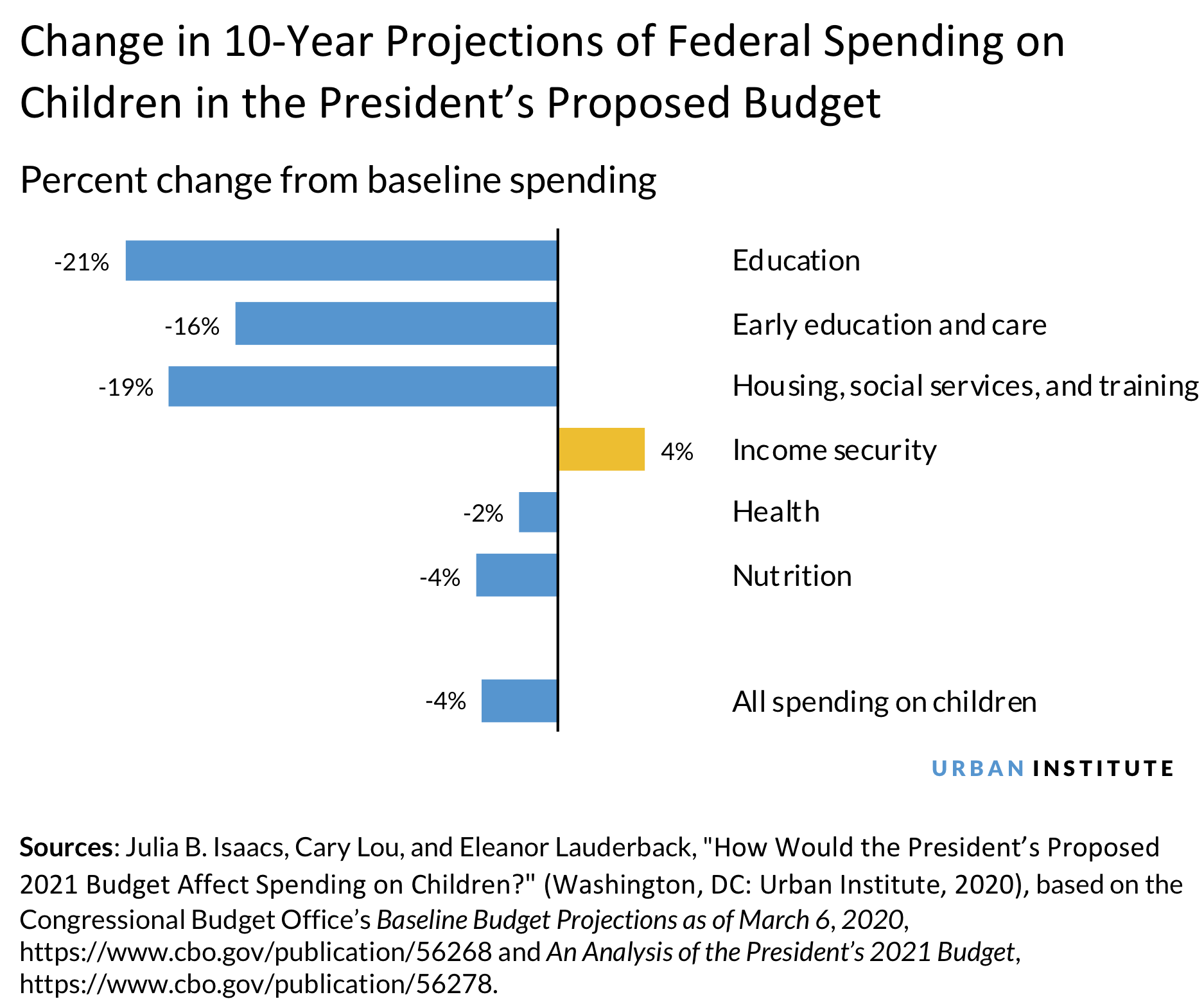
<p>Eight-year-old Allie Vanderploeg, left, a 2nd grader in Jeffco Public Schools, works with her brother, Kaden, 13, center, in 7th grade, and her sister, Maddie, 11, in 5th grade, at their home during the first day of online learning on March 17, 2020 in Lakewood, Colorado. Jeffco Public Schools implemented a remote learning and work plan where teachers, students, and staff will educate and learn from home with online programs for an unknown period due to COVID-19. (Photo by RJ Sangosti/MediaNews Group/The Denver Post via Getty Images)</p>
Before the COVID-19 pandemic swept across the United States, President Trump released his annual budget, sharing his vision for federal spending over the next year and decade. A recent Kids’ Share analysis of the 2021 budget finds that if it were fully enacted, education and other children’s programs subject to annual funding decisions would be sharply reduced below projected spending under existing law. Mandatory spending programs, including programs targeted toward both children and older adults, would remain largely protected from budget cuts.
Like many plans prepared before the pandemic, that budget is obsolete. Massive increases in federal spending to fight the coronavirus and to support the economy and millions of unemployed workers have left the budget’s spending projections outdated. Despite the changing situation, the budget is still a valuable statement of President Trump’s priorities and serves as a guide to the policies he could pursue if elected for a second term.
How the president’s proposed budget affects children’s programs
President Trump’s budget reduces funding for many programs supporting children, particularly those related to elementary and secondary education, early care and education, housing, social services and training.
The Trump administration proposes a new block grant (PDF) consolidating the current Education for the Disadvantaged (Title I, Part A) program and 28 other programs. This block grant would be funded below current-law levels, with the gap growing over time, for a total decrease of $63 billion over the 10-year projection period. Special education programs would also see spending reductions. Overall, federal spending on elementary and secondary schools would be reduced by 21 percent below baseline projections for 2021–30.
The budget proposes to reduce early care and education funding by 16 percent below current-law projections over the next 10 years, eliminating the Preschool Development Grants Program and reducing funding for Head Start, the federal early learning program for children whose families live close to the federal poverty level. Proposals to reduce spending on low-rent public housing and Job Corps and to eliminate the Social Services Block Grant would also affect children and teens, with the child-related portions of housing, training, and social services reduced by 19 percent relative to current-law projections.

The president’s budget does propose higher spending on two programs for children, driving a 4 percent increase in spending on income security programs. First, expansion of the child tax credit in 2025–30 comes as part of a broader proposal to extend certain provisions of the 2017 Tax Cuts and Jobs Act. And a new paid parental leave program would provide six weeks of paid leave to new parents.
These programs fall under mandatory spending categories, which are governed by programmatic rules and not constrained by Congress’s annual spending decisions. The budget proposes that child-related health and nutrition programs, most of which also are in the mandatory part of the budget, decrease funding by 2 and 4 percent, respectively.
Cuts to children’s programs would undermine investment in the next generation
By targeting Head Start, Title I, Job Corps, and other programs for large reductions, the president’s budget undercuts efforts to help children from disadvantaged backgrounds reach their full potential. Failing to invest federal resources in children reduces our collective investment in tomorrow’s work force.
The proposed budget targets reductions at more than just spending on children, with large reductions in nondefense discretionary spending throughout. These cuts affect a broad set of programs ranging from education and Head Start to public health, international affairs, and environmental protection, all of which have been constrained by the caps set in the Budget Control Act of 2011, as amended.
At the same time, many mandatory programs and tax credits are largely protected. Despite some proposed reductions in health care programs, the president’s budget does little to change the rapid growth in health care, Social Security, and interest costs that continue to drive federal spending well above projected revenues. Education and other children’s programs were already squeezed by this growth in health and retirement entitlement programs, even before the reductions proposed in the president’s budget.
The COVID-19 pandemic means that next year’s budget will be radically different, regardless of who sits in the Oval Office. The budget for 2022 must help the country recover from this health and economic crisis and should be more forward-looking than the last one, starting us on a path toward a healthier long-term balance between spending and revenues, so that we have resources to invest in children, public health, and other important priorities.
Let’s build a future where everyone, everywhere has the opportunity and power to thrive
Urban is more determined than ever to partner with changemakers to unlock opportunities that give people across the country a fair shot at reaching their fullest potential. Invest in Urban to power this type of work.